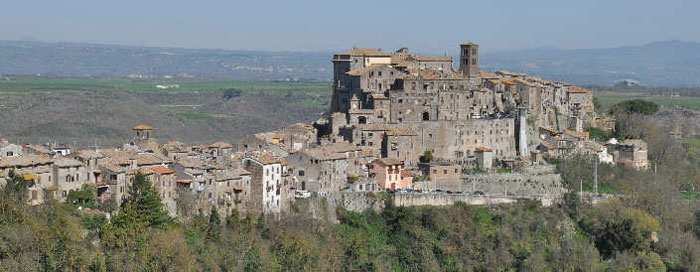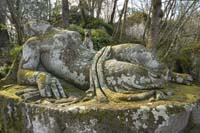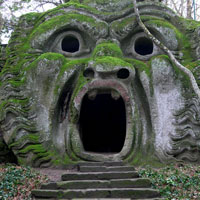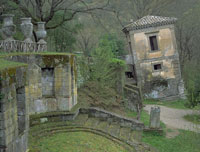Bomarzo
|
Bomarzo is a small town, located near Viterbo on the road to Orta.
|
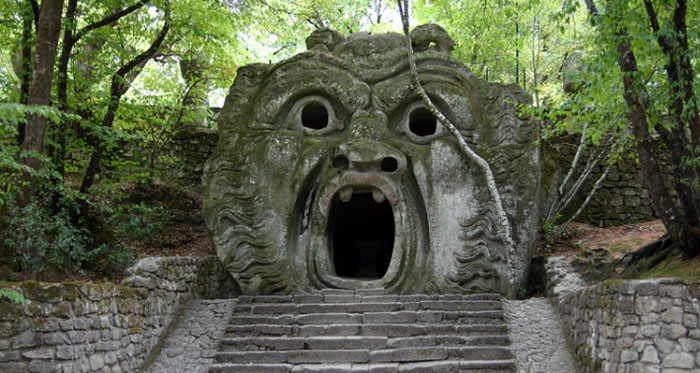 |
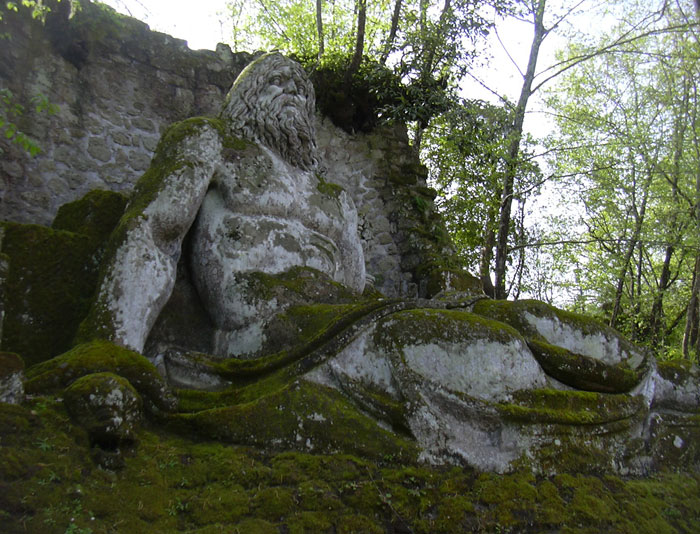 |
Bomarzo, Bosco Sacro, Neptune |
|
|
|||
In the region of Lazio, the marvellous land of the Etruscans, the Romans and the Middle Ages, lies the village of Bomarzo which shares all the glory of the region's illustrious history and possesses an historical site which is the only one of its kind in the world: "The Villa Of Marvels". In the gardens of other villas in Lazio you will find certain similirities, but the prototype of all these gardens remains the "Sacred Wood of Bomarzo", that popular fancy rebaptized as Monster's Park. Prince Pier Francesco Orsini, known as Vicino, wanted such a park "only to ease the heart". It was designed and laid out by the great architect, Pirro Ligorio, who was summoned to work at Saint Peter's in Vaticano after the death of Michelangelo. Without either Prince Orsini or Ligorio ever realizing it, a timeless masterpiece was born. When you visit this park you will go from surprise to surprise as animals and figures in stone suddenly appear: the Elephant that is about to kill a Warrior, the fighting Dragons, the Ogre in whose mouth you could pic-nic, Sleeping Beauty, Hercules tearing Cacus apart, Bears in ambush, animals with three heads, Neptune presiding figures, and finally a globe of the world balanced on the head of an Orc with a model of the Orsini Castle on top representing the power of his family. These sculptures carred out of massive boulders in situ, appearing to rise up out of the very ground as if by magic. It all goes back to the 16th Century (1552), the period which saw the development of an ideal of life between Prince and Courtier. This wood has inspired many important artists and poets of the time such as Annibal Caro, Bitussi and Cardinal Madruzzo wanted to express their wonder and wished to leave their "epigraphs and verses" carved here and there. After Vicino Orsini's death nobody cared any longer for this jewel of mannerist art and after centuries of oblivion has been saved and restored for the joy of intellectuals, men of letters, artists and tourists that come from all over the world to admire this splendid garden.
The park of Monsters of Bomarzo was devised by the architect Pirro Ligorio (he completed the Cathedral of Saint Peter in Rome after the death of Michelangelo and built Villa d'Este in Tivoli) on commision of Prince Pier Francesco Orsini, called Vicino, only to vent the heart broken at the death of is wife Giulia Farnese. The park was born in 1552 as "Villa of Wonders" to be the only one of it's kind in the world. The Park of Monsters remained in oblivion till 1954 when it was bought by Mr Giovanni Bettini who with loving care has managed it. A visit to the park will unfold in a series of stages ranging between mythology and fantasy.
|
|||
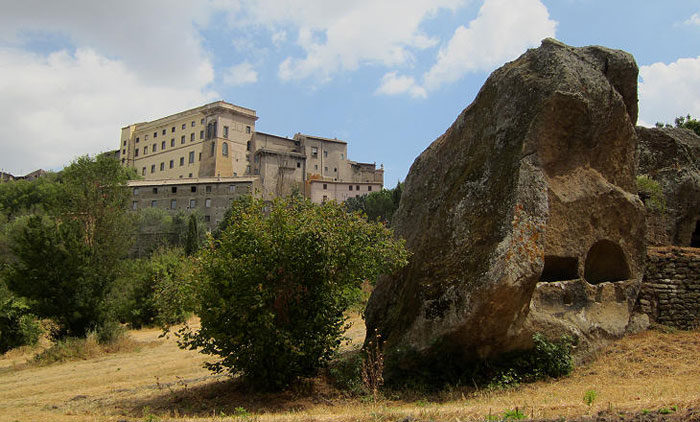 |
|||
Bomarzo and the Orsini palace seen from the valley where the Sacred Wood is situated (in the foreground a boulder with ancient tombs) |
|||
|
|||
This article incorporates material from the Wikipedia articles Bomarzo and Pier Francesco Orsini, published under the GNU Free Documentation License.This article incorporates information from the revision as of 2009-06-27 of the equivalent article on the French Wikipedia. Wikimedia Commons has media related to: Parco dei Mostri (Bomarzo) |
|||
| The main attraction of Viterbo is the town's medieval architecture: the remains of its grand Papal Palace (Palazzo dei Papi) and the humbler medieval lanes. Other individual sights of interest include a couple of museums, the town Cathedral and a selection of other palazzi and churches. Thanks to the town's lack of development since its heyday in the Middle Ages, it is now famed for one of the best-preserved medieval centres in Italy, popular with film crews in search of authentic atmosphere. A pleasant half-hour can be spent wandering the medieval lanes of San Pellegrino, a historical area of unaltered stone houses Just outside Viterbo are the natural hot springs of Bullicame, known since ancient times. Nowadays there is a thermal spa complex on the site, called Terme dei Papi (Spa of the Popes). In the province are also worth a mention the village of Bagnaia and the famous Villa Lante, a wonderful example of late Renaissance residence with an Italian garden, whose design is attributed to Jacopo Barozzi da Vignola as well as that of the Palazzo Farnese in Caprarola, another example of Renaissance pentagonal residence. The ancient village of Montecalvello rises around a castle where the famous Balthus, a contemporary painter, lived for thirty years. The Villa Farnese, also known as Villa Caprarola, is a mansion in the town of Caprarola. Around 1520 Antonio da Sangallo il Giovane, the architect of theFarnese family, expert in military architecture, was given the task of designing the residence of Caprarola. He imagined a building that, from the highest point of the country, showed the strong presence and the influence of the Farnese around the whole territory. The structure, pentagonal, with five angular and defensive bastions in the draft of Sangallo has the look and the function of a real fortress. The garden retreat in the woods, designed by Vignola, is a place of wonder. It lies in a glade at the end of a long path and is known as the Casino del Piacere (House of Pleasure). There is a water staircase, fountains, terraces, a casino and logia. It was used as a private retreat by Cardinal Odorado Farnese. Gardens in Italy | Villa Lante | Villa Farnese
|
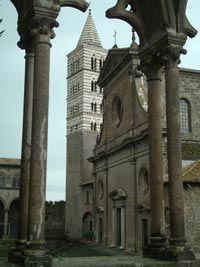 Viterbo, Cathedral of San Lorenzo Viterbo, Cathedral of San Lorenzo |
||
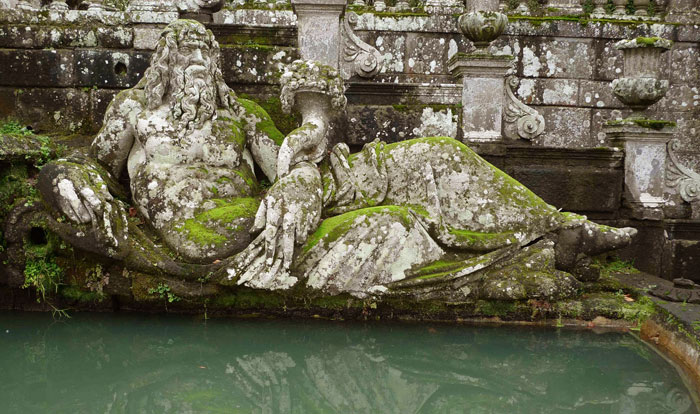 |
|||
Villa Lante, River God |
|||
Communities of the Province Viterbo | Acquapendente · Arlena di Castro · Bagnoregio · Barbarano Romano · Bassano Romano · Bassano in Teverina · Blera · Bolsena · Bomarzo · Calcata · Canepina · Canino · Capodimonte · Capranica · Caprarola · Carbognano · Castel Sant'Elia · Castiglione in Teverina · Celleno · Cellere · Civita Castellana · Civitella d'Agliano · Corchiano · Fabrica di Roma · Faleria · Farnese · Gallese · Gradoli · Graffignano · Grotte di Castro · Ischia di Castro · Latera · Lubriano · Marta · Montalto di Castro · Monte Romano · Montefiascone · Monterosi · Nepi · Onano · Oriolo Romano · Orte · Piansano · Proceno · Ronciglione · San Lorenzo Nuovo · Soriano nel Cimino · Sutri · Tarquinia · Tessennano · Tuscania · Valentano · Vallerano · Vasanello · Vejano · Vetralla · Vignanello · Villa San Giovanni in Tuscia · Viterbo · Vitorchiano |
|||

